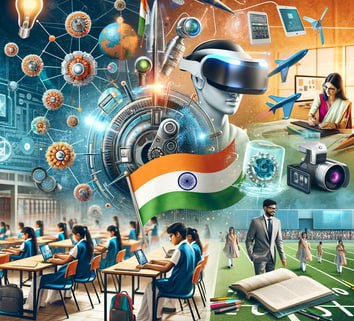Transformative trends in India’s higher education
The surge in EdTech presents opportunities for democratising education but also highlights challenges such as the digital-divide and ensuring quality
India’s higher education landscape is undergoing a transformative shift . With initiatives like the New Education Policy (NEP) 2020, skill development programs by the National Skill Development Corporation (NSDC) and the encouragement of 100 per cent FDI in education, the landscape is ripe for innovation and investment. Additionally, UGC’s push for setting up international campuses in India and the Ministry of Education’s focus on global learning is reshaping our educational framework .
The market size of the Indian higher education system was estimated at around $40 billion in 2023, growing at a CAGR of 15 per cent. With over 1,200 universities, 49,400 colleges and 12,600 standalone institutions, India hosts one of the largest higher education ecosystems in the world. Catering to more than 50 million students — a number expected to grow substantially in the next five years — these institutions are crucial in achieving an enhanced Gross Enrollment Ratio and improving the skill set of our future workforce.
Amidst this expansion, the post-pandemic era has seen a significant influx of digitisation in learning, with universities offering online programs and various platforms providing a broad spectrum of courses online. Considering our current infrastructure and the expected demand, it is essential for the country to further explore online learning and skill development opportunities. Aligning these opportunities with the next 10-year growth plan is crucial for preparing a skilled workforce that enhances graduate employability .
However, the selection of courses among students has also seen a paradigm shift . India is moving beyond traditional domains like engineering, medicine and management. Today, students are increasingly drawn to interdisciplinary programs and new-age courses that promise quicker skill acquisition and certification. There is a significant opportunity for institutions to expand their offerings in these certification/degree courses where students can learn new skills in less duration.
The surge in EdTech has been transformative and represents a key area ripe for investment and innovation. By providing everything from career guidance to student counselling digitally, these platforms have democratised access to education, ensuring that students from all regions have better career opportunities. Yet, realising the full potential of these advancements requires overcoming significant challenges. Addressing the digital divide, ensuring equitable access to technology and improving internet connectivity, especially in underserved areas, are critical. Moreover , as the field rapidly diversifies , strengthening quality assurance and adapting accreditation and regulatory frameworks are essential to maintaining standards and credibility . These bodies must adapt to the changing dynamics of higher education to uphold academic integrity and student outcomes.
The Ministry of Education’s current focus on the internationalization of higher education in India is set to have profound effects, not only on educational practices but also on the broader economy and society. This strategic emphasis will enable transnational education and student/faculty exchanges, thereby building a globally competent workforce and fostering knowledge exchange between nations.
As we look ahead, the future of higher education in India is not just about scaling-up but also about smart scaling. By embracing these trends and addressing inherent challenges, we can ensure that the sector not only expands but also elevates , providing every student with a world-class education and global opportunities.
